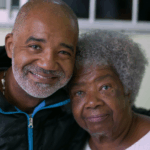Some days, it starts small—drooping eyelids, a soft slur in the voice, or a sudden wave of exhaustion that makes even brushing teeth feel like lifting weights. For people living with myasthenia gravis (MG), strength can fade as quickly as it returns.1
It’s a rare autoimmune condition that doesn’t just weaken muscles; it reshapes daily life. And for Black and Brown communities, where diagnosis can be delayed and symptoms often dismissed, awareness and support can literally change outcomes.1
Whether it’s your parent, partner, sibling, or friend, understanding this condition and how to show up can make a world of difference.
What Is Myasthenia Gravis?
MG is a chronic autoimmune condition that affects how nerves communicate with muscles.2 Normally, nerves release a chemical messenger called acetylcholine, which tells muscles when to move.2 In this condition, the body’s immune system mistakenly attacks those communication sites, blocking or weakening the signal.2
The result? Muscle weakness that worsens with activity and improves with rest.2
Common symptoms include:
- Drooping eyelids or blurred/double vision.2
- Slurred speech or difficulty swallowing.2
- Weakness in arms, legs, neck, or face.2
- Shortness of breath or fatigue after light exertion.2
Symptoms often fluctuate throughout the day—fine one hour, struggling the next. And because it mimics other conditions, MG is sometimes misdiagnosed or overlooked.2
Early detection is vital. With treatment, such as medications, antibody therapies, or surgery, many people manage their symptoms and live full, active lives.2 But that journey can be harder for some than others.
Why Awareness Matters in Black and Brown Communities
Though this condition can affect anyone, research shows that Black Americans are more likely to experience generalized and severe forms, and often face longer delays in diagnosis.1
Several factors contribute to this disparity:
- Misdiagnosis or delayed recognition: Symptoms can resemble fatigue, stress, or stroke.2 Black people are less likely to be referred early for specialized testing.1
- Access barriers: Neurologists familiar with this condition are scarce in under-resourced areas, and treatments like intravenous immunoglobulin (IVIG) or biologic drugs can be expensive.1
- Bias in pain and fatigue perception: Black and Brown patients’ reports of weakness or exhaustion are too often minimized, leading to under-treatment.1
This means awareness is more than education, it’s advocacy. When communities understand the signs, they can push for earlier diagnosis and better care.
3 Ways to Support a Loved One with MG
1. Learn and Listen with Empathy
Knowledge is one of the most powerful ways to show love. Symptoms can be unpredictable. Some days your loved one may have the energy to run errands or socialize, and the next day they might need complete rest.2 This inconsistency can be frustrating for both of you, but empathy bridges the gap between understanding and action.
How to support:
- Educate yourself on the condition. Read from trusted sources like the Myasthenia Gravis Foundation of America (MGFA). Understanding the science helps you respond with compassion instead of confusion.
- Listen without comparison. Avoid saying things like “I get tired too” or “Just push through.” Fatigue is medical, not motivational; it’s caused by the body’s inability to send muscle signals effectively.3
- Ask what they need each day. Needs can change depending on symptoms. Some days they may want help cooking; other days they just need quiet company.3
- Celebrate small victories. Getting out of bed, making breakfast, or finishing a short walk can be major wins on hard days. Recognizing effort helps them feel seen and valued.
2. Become a Partner in Care, Not Just a Cheerleader
Supporting someone with this condition means understanding that “help” goes beyond encouragement; it’s partnership. Many treatments require precise timing, ongoing lab work, and lifestyle adjustments.
How to support:
- Attend appointments when possible, or help track medications and side effects. Medications often need consistency; missing doses can trigger worsening weakness.3
- Advocate during emergencies. MG crises, which are episodes of severe muscle weakness affecting breathing, require urgent care.4 Knowing their triggers and medication list could save their life.4
- Encourage rest, not guilt. People with this condition often struggle with pacing themselves. Help them create balance by planning breaks, canceling when needed, and celebrating small wins instead of focusing on limits.
3. Build a Circle of Safety and Support
MG can feel isolating, especially for people of color who rarely see their experiences represented in medical spaces. Social support and advocacy can be life-changing.
How to support:
- Encourage community connection. Help your loved one find local or online MG support groups. The MGFA hosts virtual sessions, and several social media communities center Black and Brown experiences with rare diseases.3
- Reduce stressors. Emotional stress can worsen physical symptoms. Offer practical help: drive them to appointments, assist with bills or childcare, or simply handle chores so they can rest without guilt.
- Advocate for equitable care. If you notice delays or dismissive treatment from providers, speak up. Ask for referrals, request second opinions, and ensure your loved one’s voice is respected.
- Promote mental health. Encourage counseling or therapy if they feel anxious or depressed. Chronic illness takes a toll on emotional well-being, and mental health support is as vital as medication.
- Show up consistently. Don’t disappear once the crisis passes. This condition is lifelong, and ongoing care means showing steady, unconditional presence by checking in, visiting, and reminding them they’re more than their diagnosis.
Support doesn’t always look like grand gestures, it looks like consistency. Every text, visit, and act of care builds a safety net that strengthens both body and spirit.
Recognizing the Signs and Encouraging Early Detection
If someone you love is experiencing unexplained muscle weakness, vision changes, or fatigue that worsens with activity, encourage them to see a neurologist.2 Diagnosis includes blood tests for antibodies, nerve stimulation studies, and sometimes imaging to look for related conditions like thymus gland abnormalities.2
The earlier it’s caught, the more treatment options are available, and the greater the chance for symptom control and quality of life.
A Call to Action
Supporting someone with MG takes patience, empathy, and action. So today, check in on your loved one. Offer a hand, an ear, or a ride to their next appointment. Because real support isn’t about fixing anything, it’s about showing up.
References
- Qi, C., Narayanaswami, P., Anderson, A. E., Gelinas, D., Li, Y., & Guptill, J. T. (2025). Racial disparities in acute care utilization among individuals with myasthenia gravis. Frontiers in Public Health. doi:10.3389/fpubh.2025.1448803
- NIH. (2025, May 22). Myasthenia Gravis. Retrieved from National Institute of Neurological Disorders and Stroke : https://www.ninds.nih.gov/health-information/disorders/myasthenia-gravis
- MGFA . (2025). For Caregivers – Supporting Someone with MG. Retrieved from Myasthenia Gravis Foundation of America: https://myasthenia.org/living-with-mg/find-support/for-caregivers/
- MGFA. (2025). MG Emergencies. Retrieved from Myasthenia Gravis Foundation of America: https://myasthenia.org/living-with-mg/mg-emergency-preparedness/mg-emergencies/








